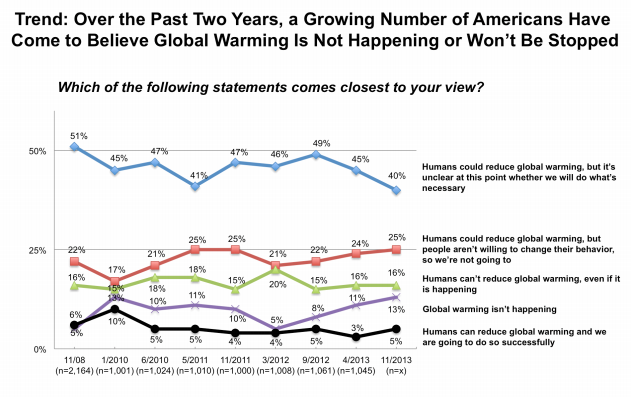In November 2013, the Yale Project on Climate Change Communication published a report on Americans’ sentiments regarding climate change. “Climate Change in the American Mind” reports how beliefs, emotions, and perceptions of global warming have changed over the last several years. It reveals that, since 2008, Americans have become less interested in climate change, less worried about its impacts, and more discouraged that it can be resolved.
Today, less than 2/3 of Americans (63 percent) believe global warming is happening. The number of ‘believers’ has actually declined eight percent since 2008, while the number of ‘non-believers’ has increased from 10 percent to 23 percent. Despite nearly unanimous consensus among scientists that climate change is occurring, and driven by human activity, the number of Americans who believe global warming is human-caused has declined from 57 percent to 47 percent.
As for emotions regarding climate change, Americans today feel less worried (down 10 percent since 2008) and less interested (down eight percent since 2010) in the issue. Furthermore, Americans perceive global warming to be a distant threat – an issue that will be more harmful to other geographies or other generations than their own.
Of the population that does believe global warming is happening, there are mixed attitudes regarding solutions to reduce its impact. Nearly 2/3 of Americans believe individuals are becoming more informed about global warming and are already taking action to reduce its impacts, whereas others believe people and corporations are too greedy and self-interested to act against global warming. Only five percent of Americans believe humans will successfully mitigate global warming.
How do Americans’ behaviors reflect these attitudes? If a large portion of the American population believes, first, that global warming is not happening, second that any change that is occurring is not human-influenced, and third, that there’s nothing that can be done to solve it, then is it unlikely that they will take action to reduce their contribution to the problem and proactively seek a solution. Last year, U.S. carbon dioxide emissions increased by two percent. In many zip codes across the country, the average household carbon footprint is as high as 80 metric tons of CO2eq. Likewise, investment in climate change solutions has declined in past years, potentially influenced by Americans’ belief that people are unable or unwilling to make a difference in reversing climate change. For decades, investment in energy has favored carbon-intensive fossil fuels over low-emission renewable sources. For the past two years the U.S. has reduced its clean energy investment, with a more than eight percent decrease in 2013 from $53 billion to $48.8 billion.
But there is hope. Last week, UNFCCC chief, Christiana Figueres, called on global financial institutions to divest their money from fossil fuels and triple their investments in clean energy. And even despite declining clean energy investment, installed wind and solar continues to skyrocket across the country due to lower production and installation costs. Early reports indicate that in 2013 the U.S. installed more solar than Germany, the global leader in solar power. That creates a virtuous race to the top. Energy efficiency has also increased substantially for countless products in the U.S. market. Many home appliances today use a fraction of the energy they did just decades ago, and President Obama’s Corporate Average Fuel Economy (CAFE) Standards will increase the efficiency of light-duty vehicles by nearly 40 percent by 2025. We hope to see these efforts to reduce emissions across the power and transportation sectors grow dramatically in the coming years to help substantially reduce global emissions.


